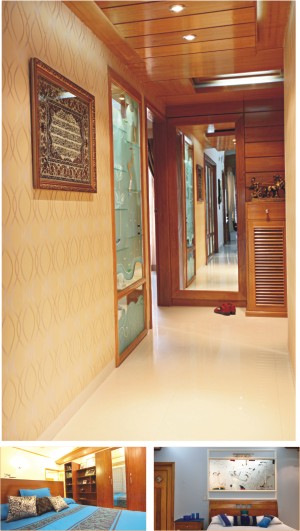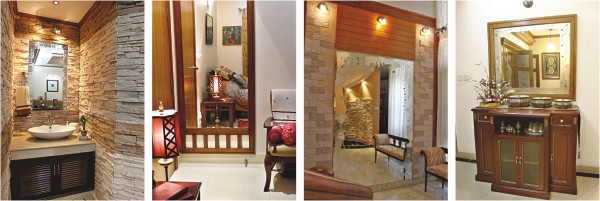DECOR
MIRRORS ON the wall
 Although technically nothing but reflective glass, mirrors have probably done more to define modern-day culture than any other invention. While a mirror may tell you how you look, all depends on the way you look at yourself.
Although technically nothing but reflective glass, mirrors have probably done more to define modern-day culture than any other invention. While a mirror may tell you how you look, all depends on the way you look at yourself.
Mirrors have a long history of use both as household objects and as objects of decoration. The earliest mirrors were hand mirrors; those large enough to reflect the whole body did not appear until the 1st century AD. Hand mirrors were adopted by the Celts from the Romans and by the end of the Middle Ages had become quite common throughout Europe, usually being made of silver, though sometimes of polished bronze.
From the late 17th century onwards, mirrors and their frames played an increasingly important part in the decoration of rooms. The early frames were usually made of ivory, silver, ebony, tortoise shells or veneered with marquetry of walnut, olive, and laburnum. Needlework and bead frames were also to be found. The tradition of incorporating a mirror in the space over the mantelpiece soon became established; many of the early versions of these mirrors, usually known as overmantels, were enclosed in glass frames.
This week, we focus on the mirror's effect and influence on our homes. There was a time when mirrors were almost exclusively ladies' accessories, but over the years it has become a functional and necessary home décor item. Aside from the common uses, mirrors can also be used to create the illusion of space.
A large mirror correctly placed can make any room look larger. A large mirror at the entrance is especially good for this purpose. Whether placed at the end of a hall or angled in a corner of a small apartment, the result is the illusion of space. Coupled with proper lighting, any studio apartment can be made to look spacious.
The correct mirrored furniture can also be used for the same effect. Generally, we placed mirrors in the foyer or on the entrance walls. It is a matter of convenience for both resident and visitor to be able to see their own image when they enter and leave the house.
To maximise space utilisation -- leaving enough space for furniture is very important in our ever-shrinking city homes -- we can attach mirrors on the backs of doors. We can also install mirrors on the walls adjacent to the backs of doors and relocate the switchboard.
Small mirrors can be picked up cheaply at sales, and factory outlets. They improve the illumination in a room when hung together on the wall. All these mirrors have 'bevelled edges' rather than frames; this look was popular in the first part of the 20th century, so you are more likely to find these second-hand than new.
If you are an antique lover, you should go for antique mirrors. It's a really worthy investment to create a dramatic impact. Don't be tempted to replace old glass with new, however tarnished it is, or you alter the character of the antique piece.
Generally each and every bathroom mirror hangs above a basic hand wash sink. Hanging a mirror is not only an easier option than attaching sheets of glass to the wall, but it also adds warmth and character to a bathroom. When installing a mirror in a bathroom, remember that people's heights vary. In the modern interior we also use decorative mirrors on the bathroom wall and sometimes on the false ceiling.
We installed similar tiled designs in the mirror in the bathroom for beautification. For festive or special occasions a new decorative mirror attachment acts as a quick makeover.
A simple store mirror can be transformed by the application of a coat of paint. The colour should echo the other shades in the room. When you are hanging a mirror, always check to see what it will reflect -- the reflection of a charming chandelier or an attractive wall opposite is much more desirable than that of an ugly view outside or a part of your house you don't want to emphasise. More appealingly, you can 'double' your view of your garden by hanging a large mirror near or opposite the window overlooking it.
Nazneen Haque Mimi
Interior Consultant
JOURNEYMAN
E-mail: journeyman.interiors @gmail.com
Photo Credit: Journeyman archive

PHOTO FEATURE
Diving into
vastness
It's good news that just a couple-of-hour's drive -- or even less -- can take you to a place surreal enough to fill your heart with ecstasy and joy, and peaceful enough to allow you to rejuvenate yourself.
Just out of the urban jungle, Mawa Ghat is a haven where the infinite, blue skies and large, green fields and furious, cloudy seas meet. And the weather can never be as perfect as it is now. Almost at the end of monsoon, an epilogue of gloomy, continuous rain makes up for a splendid tour.
Get together with friends and take a day out. Games like “beach” football and volleyball -- even cricket -- come handy. After the game treat yourself to local fish delicacies. Hire a speed boat to break free from the world. And, plan an open air barbeque party.
Or, if not with friends, taking your special, loved one to Mawa Ghat is paramount -- the slow but steadily growing grudges and widening gaps will cease to exist -- lost amidst the vastness of blue and green.
Mawa Ghat is an invigorating experience, a day trip far away from the madding crowd. Sazzad Ibne Sayed feels it through his camera lens, capturing the joy and a latent, abstract melancholy.

By M H Haider
